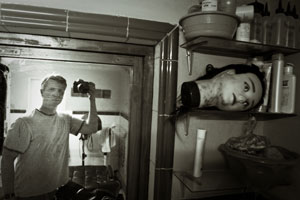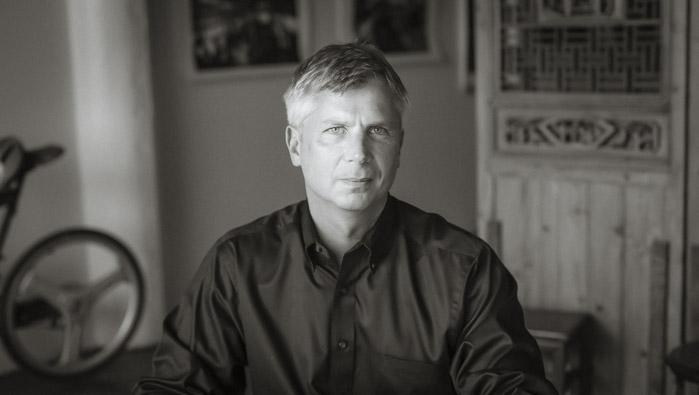JESSE PESTA
♦ Hi, I’m the deputy editor for climate and environment at The New York Times, as well as a photographer and former foreign correspondent based out of India and Hong Kong for The Wall Street Journal. I hail from a place called Starve Hollow and I sincerely hope that I am friendlier than the photo makes me look.
♦ As a reporter I’ve written about the massacre of the royal family in Nepal, trains made out of bamboo in Cambodia and the 9/11 terrorist attacks from Pakistan. At both the Times and the Journal, projects I’ve edited have been recognized as finalists for the Pulitzer Prize.
♦ Nice words have been said by nice people from Boingboing, Human Rights Watch, the Annals of Improbable Research, the Museum of Modern Art and also planet Twitter.
♦ Once upon a time, a story I wrote about traffic jams in the Himalayas was passed around by the Dalai Lama.
JOURNALISM
♦ As deputy editor on the Times’s climate desk I focus on visual, investigative and narrative projects. Our reporting on the Trump administration’s denial of science was a finalist for the Pulitzer Prize in Public Service. Visual projects have included:
An investigation using special cameras to expose “super emitters.” • A narrative of the history behind Chicago’s surprising vulnerability. • This visualization of a crisis in the Gulf Stream. • John Branch’s graceful look at the ancient living things we’re losing.
♦ Before climate I oversaw the NYT’s investigative business reporting. Projects there included “Bottom Line Nation,” “Addiction Inc.” and many long-form cover stories for Sunday Business, a section in the Sunday Times print editions that I also edited.
♦ Before joining the NYT I was a foreign correspondent for The Wall Street Journal. So here’s the piece about trains made out of bamboo. While on the Journal’s Page One investigative and features desk, I also edited many investigative and narrative projects including a multi-year report on privacy that was a Pulitzer finalist.
♦ As a reporter I’ve written about:
A candy shop that treats
burn victims. • A
nightmare on India’s Route 66 (with this
interactive). • A young mother
set on fire. • Violent
cow-rights activists. • Nepal’s terrible
earthquake (photo essay). • A
surreal drill team. • India’s
accidentally groovy wristwatches. • A
wicker basket for abandoning babies.
One-horsepower taxis. • The
child-goddesses of Kathmandu. •
Coin divers in a sacred river. • The
world’s fastest ocean liner (with
video). • An
anachronistic parade in the American midwest. • The bizarre rumor mill that flourished after Nepal’s king was killed by his son.
♦ As an editor over the years I’ve been lucky to work with brilliant reporters on:
This critical re-examination of Truman Capote’s masterwork “In Cold Blood.” • One woman’s first-person investigation into her ex-husband’s death (this became a book). • A man who got a criminal record because of a clogged toilet. • San Francisco’s housing anarchists (this became a book too). • Vietnam’s bride kidnappers. • FBI informants who snitch on their girlfriends.
PHOTOGRAPHY
♦ Please visit Starve Hollow Road, which is named for the place where I grew up. I’m also on Instagram.
♦ Photography by me has been published in The Wall Street Journal (for example here, here, here, here and here), Marie Claire, The Daily Beast, Newsweek and other publications. My photos have been exhibited at the Exit Art gallery, New York; Photographic Gallery, Front St., New York; Chrystie Street Gallery, Chrystie St., New York; ABC No Rio, Rivington St., New York; the Southern Indiana Center for the Arts; and the Edward Hopper House, Nyack, N.Y.
NEWS
♦ For all your Jesse Pesta news, there’s always Twitter @jessepesta. Until then:
♦ May 2020: Our year-long project examining the Trump administration’s denial of science was a finalist for the Pulitzer Prize in Public Service.
♦ January 2018: After more than two years editing business investigations and enterprise projects, and serving as editor of the Sunday Business section, I’m thrilled to be joining the NYT’s climate team as deputy editor. There’s no bigger story.
♦ December 2017: A narrative project I led, Addiction Inc., was published as a special 16-page, four-story section. It’s first time the Times has published a multi-part project as a standalone section.
♦ July 2016: A piece I wrote with Preetika Rana, “The Dangerous Meeting of Women and Fire,” won the the South Asian Journalists Association’s top prize for enterprise reporting.
We also received honorable mention for feature writing from the Society for Features Journalism ~ a particular honor considering that the winning project was a Pulitzer recipient.
♦ July 2016: The interactive project “Death on India’s Route 66” I wrote and reported with Krishna Pokharel and Preetika Rana was awarded the Clarion prize for feature writing. Here’s the interactive part of the project, where we profile everyone on the bus that fateful night.
♦ January 2016: Delighted to be an adviser again to master’s students at Columbia University’s graduate program for investigative journalism, the Stabile Center.
♦ Oct. 7, 2015: Here’s my first NYT byline, a news-breaking piece on the S.S. United States.
Update: Against all odds, the ship might actually sail again.
♦ Sept. 21, 2015: I’ve joined The New York Times as an enterprise and project editor.
♦ January 2015: Xeni Jardin at Boingboing kind of digs the lede on this piece about a surreal yet badass motorcycle stunt team.
♦ September 2014: The Dalai Lama pulls out a copy of this thing that I wrote.
♦ April-June 2014: “The Lobotomy Files” is honored by the National Press Club and receives the 2014 Ancil Payne Award for Ethics in Journalism. This is the second project I’ve edited to receive Ancil Payne honors: In 2010 (see below) Farnaz Fassihi’s outstanding reporting on Iran, “Hearts, Minds and Blood,” was recognized.
Describing “The Lobotomy Files,” the judges said: “We are particularly impressed with the ethical consciousness” behind the determination to do the story right, “for the man who was still alive.”
♦ February 2014: After six years as a Page One editor, I returned to reporting for the WSJ as a traveling writer focused on South Asia.
♦ Oct. 15, 2013: The International Consortium of Investigative Journalists honors the Journal’s reporting on tuberculosis with the Daniel Pearl prize, its highest award.
♦ April 16, 2012: “The End of Privacy,” The Wall Street Journal’s coverage of the erosion of privacy in the U.S., is named a finalist for the Pulitzer prize in explanatory reporting.
♦ June 3-Aug. 5, 2011: Selected photos on exhibit at the Exit Art gallery in New York as part of the gallery’s Contemporary Slavery exhibition.
♦ March 26, 2011: Represented The Wall Street Journal in a presentation at Yale Law School to discuss personal privacy and the online advertising business.
♦ Sept. 25, 2010: I spoke about working with Danny Pearl in South Asia at Music for Humanity, a concert commemorating Danny’s life.
Here’s a video of my remarks. The talking starts about a minute in.
♦ April/May, 2010: The WSJ’s Iran coverage, “Hearts, Minds and Blood,” wins two prizes for foreign correspondence, from the Society of Professional Journalists and the Overseas Press Club, as well as the Robert F. Kennedy award and the Payne Award for Ethics.
♦ April 8, 2010: Represented the Journal on a Nieman Foundation panel on fairness in writing at Harvard.
♦ Aug. 12, 1994: My first “A-hed,” about an unusual parade, hits the Journal’s front page.
MAKE CONTACT
Jesse @ JessePesta • com

Copyright © 2004-2021 Jesse Pesta
All rights reserved
The portrait at the top of the page is the work of the wonderful Jennifer MacFarlane
